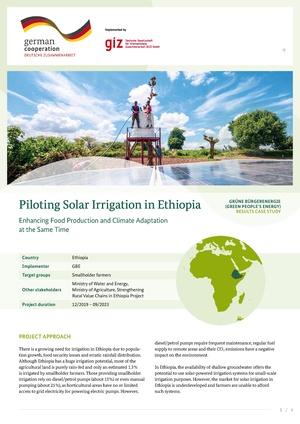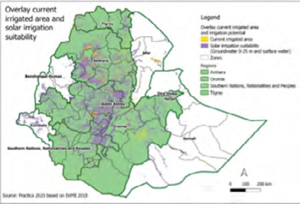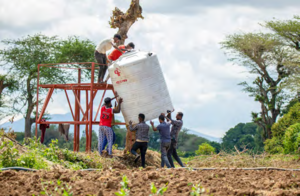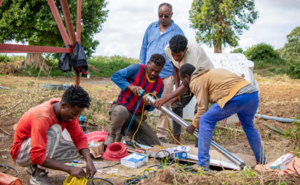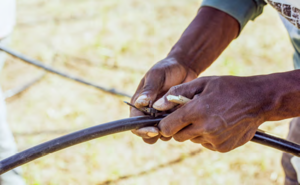Knowledge fuels change - Support energypedia!
For over 10 years, energypedia has been connecting energy experts around the world — helping them share knowledge, learn from each other, and accelerate the global energy transition.
Today, we ask for your support to keep this platform free and accessible to all.
Even a small contribution makes a big difference! If just 10–20% of our 60,000+ monthly visitors donated the equivalent of a cup of coffee — €5 — Energypedia would be fully funded for a whole year.
Is the knowledge you’ve gained through Energypedia this year worth €5 or more?
Your donation keeps the platform running, helps us create new knowledge products, and contributes directly to achieving SDG 7.
Thank you for your support, your donation, big or small, truly matters!
Piloting Solar Irrigation in Ethiopia
Piloting Solar Irrigation in Ethiopia
Project Approach
There is a growing need for irrigation in Ethiopia due to population growth, food security issues and erratic rainfall distribution. Although Ethiopia has a huge irrigation potential, most of the agricultural land is purely rain-fed and only an estimated 1.3 % is irrigated by smallholder farmers. Those providing smallholder irrigation rely on diesel/petrol pumps (about 13 %) or even manual pumping (about 25 %), as horticultural areas have no or limited access to grid electricity for powering electric pumps. However, diesel/petrol pumps require frequent maintenance, regular fuel supply to remote areas and their CO2 emissions have a negative impact on the environment. In Ethiopia, the availability of shallow groundwater offers the potential to use solar-powered irrigation systems for small-scale irrigation purposes. However, the market for solar irrigation in Ethiopia is underdeveloped and farmers are unable to afford such systems.To explore the potential of solar irrigation, the programme Green People’s Energy (Grüne Bürgerenergie, GBE) conducted a market study on solar irrigation in Ethiopia and used the results to design a pilot project to establish showcases of solar-powered irrigation systems that increase agricultural production. The project targets smallholder farmers in the Amhara and Oromia regions and collaborates with Strengthening Rural Value Chains in Ethiopia (SRVC), a BMZ-funded project implemented by GIZ. The project approach is to install solar irrigation systems for members of horticultural cooperatives and farmer groups. Sites are selected in cooperation with the SRVC project, taking into account cooperatives or farmer groups that have previously worked with SRVC.
The technical implementation of the systems consists of digging shallow groundwater wells, installing permanent water tanks as well as solar water pumps and drip irrigation systems. These steps are complemented by training in maintenance and operation. The selected cooperatives contribute labour to fortify access roads and to level the fields for the installation of the solar irrigation systems. The pilot project also aims to increase awareness and knowledge of solar irrigation by establishing institutionalised training capacities at the Ethiopian Water Technology Institute (EWTI) in Addis Ababa, as well as at the Alage Agricultural Technical and Vocational Education and Training (ATVET) institute, near the town of Batu in the Oromia region.
Methodology of Data Collection
Data for this case study report was collected through a review of project documents and six qualitative interviews with representatives of GIZ, the Ministry of Water and Energy, the Ministry of Agriculture, solar companies, and cooperatives (Mulat Worke and Ataly Geta). The case study was conducted between May 2023 and July 2023. At that time, some project activities were still ongoing. Accordingly, the effects captured are not exhaustive.
Key Findings
Project Achievements
The project installed 20 solar irrigation systems at selected and clustered smallholder farmer sites in the Amhara and Oromia regions. While in Amhara, one pump serves one site, the geographical proximity of the farmers in the second cluster in Oromia allowed the pump to be shared by two farmers in most cases. This was achieved by extending and interconnecting the drip irrigation lines, so that they stretch out to two plots, while only being served by one pump. In addition, the project trained members of the cooperatives in the functioning and operation of the solar irrigation systems. The training also covered improved irrigation techniques, such as efficient drip irrigation, and best practices for harvesting crops such as onions and potatoes. The drip irrigation systems cover areas ranging from 1,200 to 2,500m2.The project also installed two solar irrigation systems in EWTI and Alage ATVET for practical teaching, demonstration and awareness-raising purposes. Moreover, the project trained eleven trainers from the private and public sectors, 38 vocational training teachers, as well as more than 60 technicians and end-users from the agricultural, solar, and irrigation sectors. The project provides a comprehensive solar irrigation training manual, written in simple language, and covering key aspects of the sizing, installation, and operation of the solar irrigation systems. The manual is available in three languages – English, Amharic, and Oromo – and has been developed in close collaboration with the Ministry of Water and Energy and the Ministry of Agriculture. The developed training manual is being used by both ministries, farmers and cooperatives, training institutions and other relevant stakeholders.
Intermediate Impact
For some cooperatives, the installation of irrigation systems was completely new while for others, it has replaced manual water pumps or diesel pumps. For the former, the project has provided access to valuable shallow groundwater, and for the latter, the project has enabled the switch from manual- or diesel pumps to solar pumps. Manual pumps are time-consuming and require considerable physical effort to pump small volumes of water. The use of solar irrigation has enabled these farmers to save time for other work. One smallholder stated, “The benefit of it is that now we don’t need to labour to fetch water. So, the solar irrigation system helped me to save my energy a lot”.The solar irrigation systems have enabled smallholder farmers to increase their agricultural productivity. A member of one of the cooperatives reported that solar irrigation has enabled them to increase their potato production by shortening the growing period of this crop. They are now able to grow potatoes two to three times a year, compared to one time before, which could translate into increased income. In addition, the quality of irrigation has improved (irrigation frequency and volume of irrigation water). Encouraged by the positive results, the farmers are also planning to increase and diversify their crops. They plan to grow other vegetables such as carrots, onions, and cabbage, hence making the most out of their limited plot sizes. The farmers use the solar irrigation system free of charge. In some cases, non-member farmers adjacent to the solar irrigation system are also allowed to use the irrigation system for a fee. In addition, solar irrigation is an effective climate change adaptation tool that can be used to address the negative impacts of declining rainfall and enhance smallholder farmers’ resilience to the impacts of climate change.
Climate Impacts
Following the calculation methodology of the United Nations Framework Convention on Climate Change (UNFCCC), the installations described above are estimated to mitigate 32.8 t CO2 e/a in the year of installation by avoiding and/or replacing the use of fossil fuels. This is roughly equivalent to the annual CO2 emissions of more than 23 medium-sized cars in Germany.
Challenges in Project Implementation
First, the implementation of the project was affected by the COVID-19 lockdown, which led to significant delays in the coordination and initial meetings with key stakeholders on federal level and in the regions. Second, the civil war in the northern regions of Ethiopia (mainly Amhara and Oromia) has severely restricted the movement of international and local experts too. Roads have been cut off and security concerns have increased, making it impossible to visit these regions and attend meetings with the cooperatives.
Third, the solar irrigation market in Ethiopia is still in its infancy. Local solar companies face several import-related challenges such as a lack of foreign currency, which results in a limited stock of materials and long processing times of orders.
Sustainability of the Intervention
The cooperative development expert from the local Woreda (an administrative division/district) monitors the use of solar irrigation systems by the end-users to anticipate any technical or operational problems and ensure preventive maintenance. At the same time, the solar company that installed the solar system remains in contact with the farmers to ensure that the solar irrigation systems are operating properly. Moreover, there is a 12-month warranty on the supplied equipment, and a 6-month warranty on the installation work itself.
Furthermore, the training of cooperative members and farmers was very useful for the proper use and operation of solar irrigation systems. Some farmers have already thought about investing user fees from other farmers in a saving fund for maintenance and repair costs. One farmer group has already started collecting user fees but has not yet established a savings fund.
Conclusion and Outlook
The Ethiopian government has decided to stop subsidising diesel pumps currently used for irrigation. This decision may encourage the use of solar irrigation systems as an alternative. At the same time, the Small-Scale Irrigation Department within the Ministry of Agriculture is working hard to promote solar water pumps and irrigation through training, awareness raising and initiating new technical support programmes, such as a new programme with the Global Green Growth Institute. The project contributes successfully to the efforts of the Ministry of Agriculture, which has also conducted solar irrigation training using the developed training manual in other regions of Ethiopia: Southern Nations, Nationalities, and Peoples Region; Oromia and Sidama. Furthermore, the Ministry plans to use the training manual to raise awareness among farmers’ and civil society organisations that are interested in adapting the agricultural sector to climate change.Based on the results of the project, the Ministry of Agriculture is also working on setting standards for the solar water pumps and establishing guarantee mechanisms that suppliers have to respect for the sale and installation of solar water pumps. The significant scale-up of solar irrigation in Ethiopia will depend heavily on local solar companies having access to solar irrigation components and technologies, and eventually starting local assembly or manufacturing of these components and technologies.

